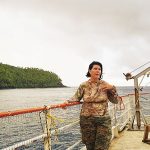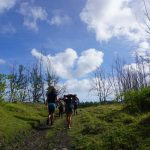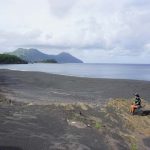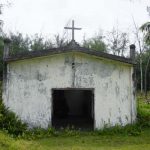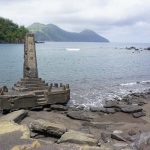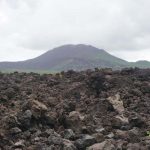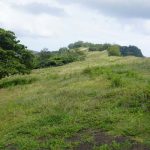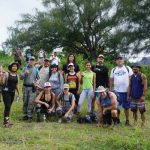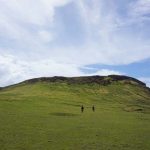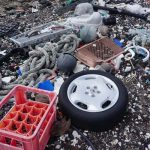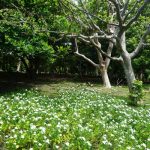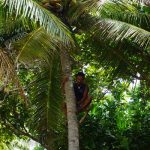Are the Northern Islands forgotten?

Pagan’s rocky cliffs rear into the sky.
PAGAN—I just came from an eight-day trip to the Northern Islands, particularly Pagan and, together with the memories and experience, I also brought back a bag of smoked meat carefully prepared by the people who live there. When I shared some with a couple of high school students on Saipan: “Here, have a taste of Pagan Island,” I was floored by their response, “What is Pagan Island?”
I cheerfully explained what and where Pagan is, shared a couple of adventures as well, but I cannot deny that I felt a pang in my heart—I shouldn’t be introducing Pagan to the young generation just so they can appreciate how special and unique that smoked meat is.
Before this trip, I knew little of Pagan. All I know is that it one of the remote and isolated islands in the northern part of the CNMI and that was enough to fuel my curiosity to get there and face the challenges of a frontier island.
Growing up, Kelly Tenorio’s knowledge of Pagan and the rest of the Northern Islands came from the archives and papers of Spanish missionaries.
“Back in the 1600s, there were thousands of people living on Pagan, Alamagan, and all the other islands. They kept the islands moving forward for us so I think we need to keep the islands moving forward for our generations to come,” said Tenorio, the Northern Island Mayor’s Office project manager. “In order to do that, we have to save it to what might happen to it. There’s someone else interested in taking over the islands for different reasons than what we would like.”
Pagan is interesting because it forms two islands that came together. It has two volcanoes—one in the north and one in the south. With its beaches, volcanoes, wild animals, and vegetation, age-old traditions are still rooted in its soil.
“It was a busy island back in the ’60s. They did copra, grew pineapples, and all kinds of agricultural things. People didn’t just live here, they thrived. They didn’t just survive, they were happy. They were healthy and industrious people. They gave birth, had children, and these children learned how to help. It was copra that was bringing in money for their families and they had a wonderful life,” Tenorio said.
“Everything kind of came into a halt in 1981 when the north side volcano erupted. Lava flowed and people had to run to the south side of the island and evacuation took place. So the island kind of closed down…in 20 years. People may have come back but not to live, just for hunting.”
According to Tenorio, the volcano is not dormant but that is not stopping people from going and living on Pagan.
“We have a lot of people that say they want to do that, [but it is] only now that we are opening it up for people to come back.” She said that in the first months of their operation, they did not anyone to return to the island as it was still a mess and didn’t have a good water source.
“The volcano it is very much alive but we see Kilauea in Hawaii and it tells us if you just live in a different area, you can live on the same island as a volcano,” she added.
The idea of resettling Pagan is more focused on the second generation more now than the original elders, Tenorio said, because many of the older generations have already died out.
“In about a year since [Northern Islands] Mayor Vicente Santos started office, we now have three islands up and running. Meaning, you can easily come here and live now. We [now have a] clean water supply, we’ve cleaned up the hazards of garbage and everything. The mayor’s office is willing to help and teach whoever wants to learn how to that and how to make a living. The islands are beautiful and have places where people can start staying temporarily until they build their own structures,” she added.
Santos said that improvements started on the islands of Agrigan, Pagan, and now, Alamagan. Efforts first started on water tank cleanup to catch rain.
“All these islands need water. That’s why I made it a priority because, without water, people cannot stay on island,” she said.
Currently there are four people on Agrigan, two on Pagan, and seven on Alamagan.
The biggest hindrance to developing the islands is the lack of regular transportation. A charter vessel brings supplies and materials to the islands every three months. “It’s challenging but we do it anyway. It’s for the people and islands,” she added.
Out of the many islands in the north, Pagan is the easiest one to get to. During World War II, the Japanese occupied the island and built an airstrip and a dock for ships to come in. The others are sanctuaries and monuments.
“So when you have that kind of a landing area, you can get goods into the island that the people would need for everyday living.”
The important thing is to revive air transportation to Pagan because the airstrip is not being used right now. Tenorio said that planes would be the most ideal mode of transportation because people don’t have the time to ride 20 hours on a ship to get there.
Unless one is with a scientific or business group that is going to the island, “you’re probably not be able to get on a vessel because there is very few vessels that come here,” Tenorio said.
“The Super Emerald belongs to my husband and I and we have taken scientists doing research and that’s how we started coming out. Nowadays, I take personal charters as well because I think that it is time now that people start coming back here and cleaning up the island, respecting and living out here because there is no reason not to. If we don’t do this, the military might take this away from us and we will never come back into it again…It will be a dead island,” Tenorio added.
She said that Pagan’s prospects are promising.
“Our group is trying to save the island for not just local people but tourists as well,” she said.
What Tenorio would like to see for Pagan is eco-tourism. “We don’t like this to be a city like Saipan…and we don’t want huge 5-star hotels either. We want this to be a natural and we are going to go with go green projects like solar panels, recycling, and everything being eco-friendly.
She also touts the island as a possible alternative solution to “our lost children in Saipan, children who are going into the penal system.” Pagan can provide a different level of therapy.
And Pagan can be a resettlement site for not just former residents but for other people as well, according to Tenorio. “There are lot of people who are not residents yet that are willing to come back here.”
“Agricultural homesteading plots, one hectare each, have been measured out on the east side, away from the lava flow and in the most beautiful part of island,” said Tenorio. “We are not encouraging people to come here to sit, eat fish and meat. We are encouraging them to be a community that works together because we want everyone who comes here and be productive. …We welcome all those people who want to come out here and do positive things for the island.”
For that, the Northern Islands needs the U.S. and local governments’ help.
“We need the government to help. …We need our waters to be patrolled. …If we say that this is our chain of islands, what makes us say that when we don’t even patrol the islands? I know that the U.S. Coast Guard has been…out here but they can’t be out here everyday. We have seen ships passing by and they are U.S. flagged ships. We know that fish are being taken. We have garbage float into our island and we know it’s not from our own ships,” she said.
Tenorio said it is great that Gov. Ralph DLG Torres is a hunter and a fisherman, has been to Pagan, and loves everything about the island.
“I think his issue here on the military is neutral and that is where he should be, so we are trying to sway him to help us bring people out here for recreational things and for better and healthier living,” she said.
Getting people back to Pagan will add meaning to this island and getting the young generation to know about it first is in the pipeline.
“I’ve been doing that and I am shocked that more than half of them don’t know where Pagan is. Maybe they’ve heard of the few islands but they don’t just need to hear of it. They need to see videos, pictures that we can give to the schools to teach history and for them to have hands on,” Tenorio said.
Spending time on Pagan without knowing its beauty, possibilities, and the challenges and threats it faces is to defy the purpose of the place. It is calling out to every person in the CNMI.
“They say we have endangered species here [on Pagan]. Yes we do, but as far as we are concerned, our people is the endangered species because they have lost or will lose their land if they don’t do something about. We need our people to get up and show an interest,” Tenorio said.
“We are in a huge hurry because…people want this island for different reasons that we don’t believe in…. Our group is not going to get tired because we believe in what we are doing and we will die fighting for this island and fighting for our people and the the generations to come. We are bringing people back and help them to be comfortable and show them that we can live comfortably, safely and be a true community out here,” Tenorio said.
- “Our work is not done until we are done telling the younger generations about these islands,” said Northern Island Mayor’s Office project manager Kelly Tenorio. (Photos by Bea Cabrera)
- Campers on Pagan start the day with a hike. Hiking is the best way to see the beauty of the island.
- Pagan Lake is just below the island’s northern volcano. Rain water is trapped in the lake before exiting to the ocean. The lake is home to eels and tilapia and is the water source for all wild animals on island.
- A hiker on the north side of Pagan looks at the volcano on the south side of the island.
- This abandoned church is a silent testimony of a once thriving and bustling community on Pagan.
- This Japanese memorial teeters on the lip of the island and withstands the harsh elements of nature. Engraved on the memorial are the words, “Everlasting Peace To All.”
- Hardened lava below the north volcano forms a wall at the end of the airstrip. Heavy equipment is needed on Pagan to clear the lava flow.
- This land has been allotted as an agricultural homestead on the east side of the island.
- Campers and explorers of Pagan pose with project manager Kelly Tenorio from the Northern Island Mayor’s Office.
- Pagan’s landscape is breathtaking.
- Pagan’s rocky cliffs rear into the sky.
- Trash from vessels that travel near the island wash ashore on Pagan.
- Undisturbed flora flourish and bloom on Pagan because of the fertile volcanic soil.
- A man climbs a coconut tree to get fruits.
- One ATV is used to transport goods around island.



